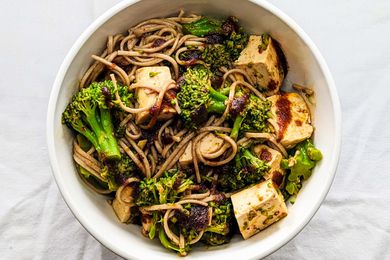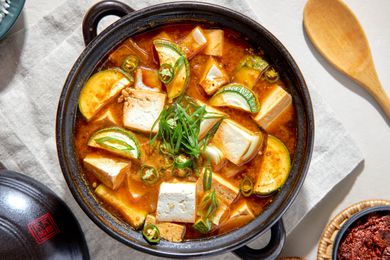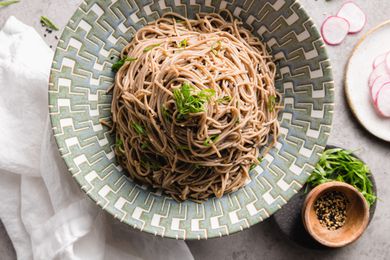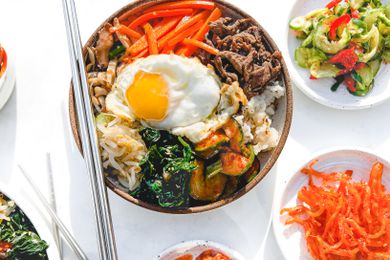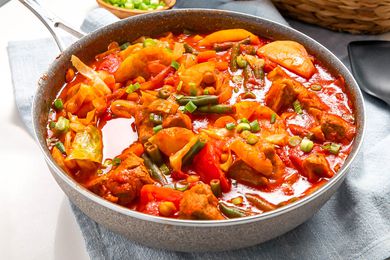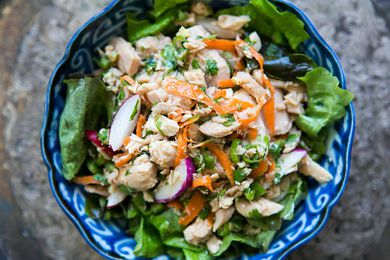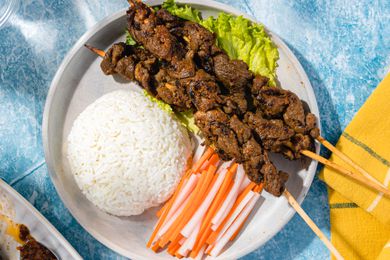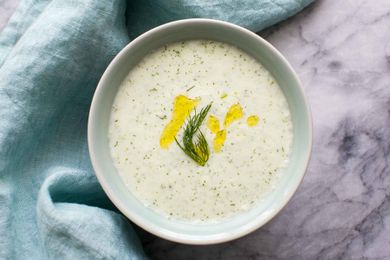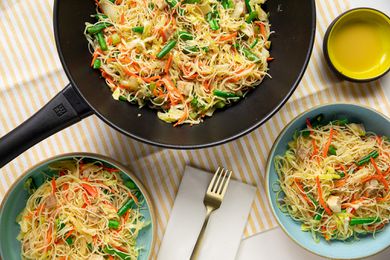:max_bytes(150000):strip_icc()/Simply-Recipes-Naengmyeon-LEAD-05-189345603d9d4df285c761d3d2776e8a.jpg)
Simply Recipes / Cynthia Christensen
I remember the first time I had mul naengmyeon. It was a boiling hot day in South Texas and I had been shooed out of the kitchen. My mom and her sisters were sitting at the table in front of the big box fan and l heard laughing and slurping and sighing. “Shi-won-hae-yo!” (“so refreshing!”) I heard my oldest aunt say.
I ran in, wanting whatever they were having, but my aunt exclaimed “no, you won’t like it!” I started to protest, so my mom scooped up some noodles from her bowl and lifted her chopsticks to my mouth.
It was so cold it made my teeth ache! My aunt was right—I didn’t appreciate it then. But my mom made me a bowl and put a scoop of hot rice in it for me and said, “someday you’ll love it cold like we do.” Moms are always right about this stuff.
:max_bytes(150000):strip_icc()/Simply-Recipes-Naengmyeon-LEAD-07-87960b3fce17494eb3aa3c426ad7dc4c.jpg)
Simply Recipes / Cynthia Christensen
What Is Naengmyeon?
Originating in the Pyongyang province of Korea, naengmyeon is a soup of cold noodles served in an icy broth (typically beef), mixed with radish water kimchi and topped with tasty garnishes. It is a cool and refreshing soup with a mild flavor, served mostly during the heat of summer.
Mul means water (although we are using a light beef broth) and naengmyeon means cold noodle—so essentially it translates to cold noodle soup.
You can customize the flavor of your soup with the addition of garnishes such as pickled radishes, pear slices, kimchi, hard boiled eggs, and sliced beef. You can even make it spicy with the addition of sauces and dried pepper.
The Best Noodles
Naengmyeon is usually prepared with buckwheat noodles. The buckwheat is often combined with some sweet potato starch or wheat, giving the noodles a very satisfying stretchy and chewy texture. Taking only a few minutes to cook, you rinse them thoroughly in cold water numerous times to remove excess starch and chill them, making them even more springy and bouncy.
Look for Korean buckwheat noodles. You can find them at most Asian markets or buy them online. Many brands come with a soup base included, but since I make my own, I usually buy a brand called Assi, which is just the noodles.
:max_bytes(150000):strip_icc()/Simply-Recipes-Naengmyeon-LEAD-08-f7e9980eb6b74dc19613255f78f102b4.jpg)
Simply Recipes / Cynthia Christensen
Varieties of Naengmyeon
This recipe is for mul naengmyeon, which is a traditional mild version originating in the Pyongyang region of North Korea. There are many other versions, including broths made with seafood, beef, chicken, or pork (sometimes all three).
My personal favorite, bibim naengmyeon, is served with a spicy red sauce. I have included a recipe for a simple spicy gochujang sauce if you want to add a little heat to your soup, just as my mom and her sisters did.
Soup Toppings, Additions, and Accompaniments
Any fresh or pickled vegetables or fruits can be served on top of your soup. Most versions include the addition of dongchimi—radish water kimchi—to the broth to add brightness to the soup.
The word dongchimi can be broken down to “dong” meaning winter and “chimi,” an old Korean word for kimchi, which gives us winter kimchi. You can buy dongchimi in the kimchi section of your local Asian grocer, but making your own takes only minutes and is ready to use in as little as 48 hours.
Make It Ahead
Making the broth, radish water kimchi, and even some of the garnishes ahead of time makes this an easy-to-assemble dish when you’re ready to cool off on a hot day!
:max_bytes(150000):strip_icc()/Simply-Recipes-Naengmyeon-LEAD-09-00fe4260f28a4db48922ac3a0fed2890.jpg)
Simply Recipes / Cynthia Christensen
Cold Dishes to Beat the Heat
Mul Naengmyeon (Korean Cold Noodle Soup)
My mom topped her naengmyeon with quick pickled radish—she always had a jar in the refrigerator. She liked the flavor better with the broth than the dongchimi radish. If you like, you can simplify the recipe by skipping the quick pickled radish and garnish your naengmyeon with the radishes from the dongchimi instead.
Ingredients
For the beef broth
-
1 pound beef brisket
-
8 cups water
-
4 cloves garlic, smashed
-
2 large green onions, cut in thirds
-
1 (1-inch) piece of ginger, peeled
-
1 1/2 tablespoons soy sauce
For the eggs and quick pickled radish (optional)
-
2 large eggs
-
1/2 large (1/2 pound) Korean radish
-
1 tablespoon kosher salt
-
1/2 cup rice wine vinegar
-
1/2 cup water
-
1/2 cup sugar
For the spicy gochujang sauce (optional)
-
3 tablespoons gochujang (Korean chili paste)
-
2 tablespoons soy sauce
-
2 tablespoons toasted sesame oil
-
2 tablespoons honey
-
1 tablespoon rice vinegar
-
1 tablespoon toasted sesame seeds
-
3 cloves garlic, minced
For the noodles and garnish
-
24 ounces Korean buckwheat noodles (such as Assi brand)
-
Pickled radish, from the dongchimi
-
2 sliced Persian cucumbers
-
1 Asian pear, sliced
-
2 green onions, julienned
-
Hard boiled eggs
-
Sliced brisket (optional)
-
Dongchimi with brine
Special Equipment
- Cheesecloth
Method
Beef broth and toppings (make 1 day ahead)
-
Make the beef broth:
In a large bowl, cover the brisket with cold water and allow it to soak for 1 hour. Drain and rinse the beef and place in a large stock pot or Dutch oven along with the 8 cups of water, garlic, green onions, and soy sauce. Bring to a boil and reduce to a simmer.
Allow to simmer until a sharp knife inserted into the beef goes in easily, about 1 hour.
Tip
If you want to serve with sliced brisket (although my mother did not do this, it is common), remove the meat from the broth. Allow it to cool, dry it off with a paper towel, wrap in plastic wrap, and refrigerate until ready to serve.
Strain and cool the broth, then transfer to a covered container. Chill in the refrigerator overnight.
![Brisket in a Pan of Water for Naengmyeon (Korean Cold Noodle Soup) Recipe]()
Simply Recipes / Cynthia Christensen
![Beef Brisket in a Pot With Broth Ingredients (Green Onions, Garlic, Water, and Soy Sauce) for Korean Cold Noodle Soup Recipe]()
Simply Recipes / Cynthia Christensen
-
Make the hard boiled eggs:
Place the eggs in the bottom of a pot and cover with cool water. Place over high heat and bring to a rapid boil. Remove from heat, cover, and let stand for 10 minutes.
Drain the water and immediately run cold water over the eggs until cool. Refrigerate, unpeeled, until ready to serve the soup.
-
Make the quick pickled radish (optional):
Peel, wash, and slice 8 ounces of Korean radish into very thin half moons, about 1/8 inch thick. In a bowl, mix the sliced radishes and kosher salt. Let sit for 30 minutes. Rinse well and set aside.
Whisk together the vinegar, water, and sugar until the sugar dissolves. Pour over the radishes, cover, and place in the refrigerator for at least 2 hours, but preferably overnight.
![Quick Radish Pickle Brine Poured Into a Jar of Sliced Radish for Mul Naengmyeon (Korean Cold Noodle Soup) Recipe]()
Simply Recipes / Cynthia Christensen
Assemble the naengmyeon
-
Chill the broth (optional):
Much of the appeal of naengmyeon is its icy, refreshing broth. If you want to take that chill over the top, place your broth in the freezer for 2 hours before serving. It will develop frosty little flecks of ice.
-
Make the gochujang sauce (optional):
Combine the gochujang, soy sauce, sesame oil, sugar or honey, rice vinegar, sesame seeds, and minced garlic in a small bowl and whisk to combine. Set aside.
![Bowl of Spicy Gochujang Sauce Ingredients (Garlic, Toasted Sesame Seeds, Soy Sauce, Gochujang, etc). Mixed Together Using a Pair of Chopsticks Naengmyeon]()
Simply Recipes / Cynthia Christensen
-
Prepare the garnishes:
Slice the cucumbers into thin slices or in small batons. Peel and slice the Korean pear into thin slices. Julienne the green onion.
Peel the hard boiled eggs and slice in half lengthwise. If using the cooked beef from the broth, slice the cold brisket against the grain into thin slices.
-
Cook the noodles:
Cook the noodles according to package directions. Rinse the noodles under cold water several times to remove the starch and cool them down. Serve immediately.
-
Assemble the soup bowls:
Place a serving of noodles in the center of four large bowls. Pour 2 cups of cold beef broth and 1 cup of dongchimi brine around the noodles. Garnish with thin slices of brisket (if using), quick pickled radish or the radishes from the dongchimi, sliced pear, cucumbers, green onions, and half of a hard boiled egg.
If you would like some spice, add a spoonful of the spicy gochujang sauce and mix it into your broth. Slurp and enjoy!
Love the recipe? Leave us a review and stars below!
![Bowl of Naengmyeon Topped With a Halved Hard Boiled Egg, Cucumber Ribbons, and Julienned Green Onions Next to a Grey Kitchen Towel and Bowls of Toppings (One Bowl With Sliced Cucumbers, Kimchi, and Julienned Green Onions, Another With Spicy Gochujang Sauce, and a Bowl of Halved Hard Boiled Eggs)]()
Simply Recipes / Cynthia Christensen
| Nutrition Facts (per serving) | |
|---|---|
| 338 | Calories |
| 8g | Fat |
| 51g | Carbs |
| 20g | Protein |
| Nutrition Facts | |
|---|---|
| Servings: 4 | |
| Amount per serving | |
| Calories | 338 |
| % Daily Value* | |
| Total Fat 8g | 11% |
| Saturated Fat 3g | 14% |
| Cholesterol 201mg | 67% |
| Sodium 561mg | 24% |
| Total Carbohydrate 51g | 18% |
| Dietary Fiber 4g | 16% |
| Total Sugars 11g | |
| Protein 20g | |
| Vitamin C 28mg | 140% |
| Calcium 99mg | 8% |
| Iron 3mg | 16% |
| Potassium 580mg | 12% |
| *The % Daily Value (DV) tells you how much a nutrient in a food serving contributes to a daily diet. 2,000 calories a day is used for general nutrition advice. | |
:max_bytes(150000):strip_icc()/Simply-Recipes-Naengmyeon-METHOD-07-cd689aff4a984acab2628597d33c2555.jpg)
:max_bytes(150000):strip_icc()/Simply-Recipes-Naengmyeon-METHOD-04-2123dac5e4f544eab68856bf21b15c18.jpg)
:max_bytes(150000):strip_icc()/Simply-Recipes-Naengmyeon-METHOD-06-8fbbec2e98484471922ce9ec2dfc1c76.jpg)
:max_bytes(150000):strip_icc()/Simply-Recipes-Naengmyeon-METHOD-08-963a4f34fb2a445ca9b3913d9c5958e6.jpg)
:max_bytes(150000):strip_icc()/Simply-Recipes-Naengmyeon-LEAD-02-354e475b0de340cc945cb4e0f5c09162.jpg)
